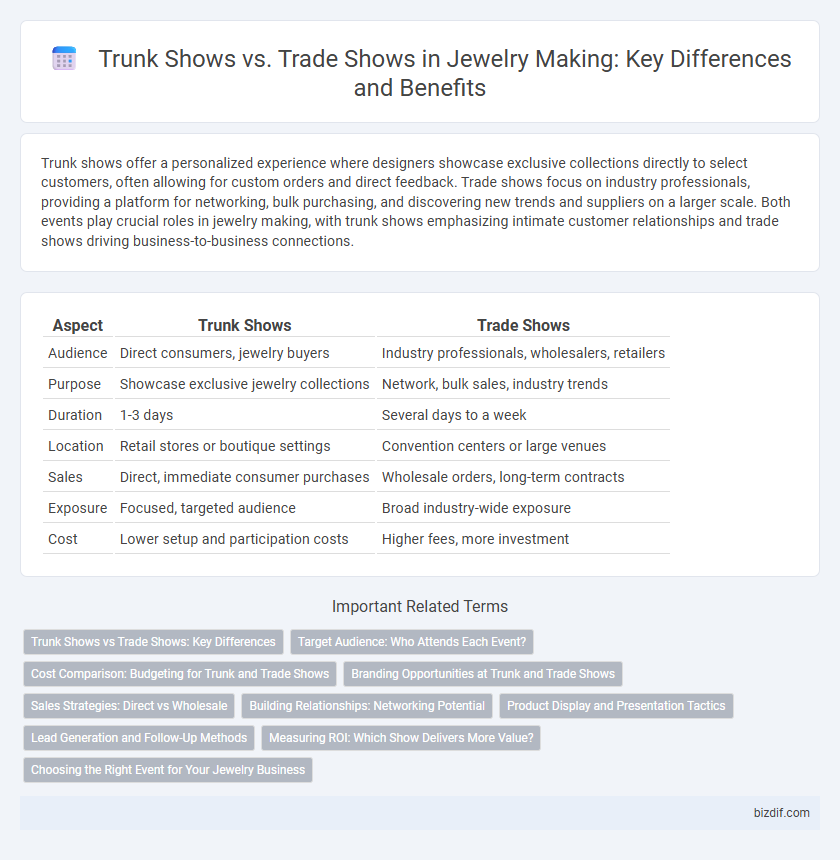Trunk shows offer a personalized experience where designers showcase exclusive collections directly to select customers, often allowing for custom orders and direct feedback. Trade shows focus on industry professionals, providing a platform for networking, bulk purchasing, and discovering new trends and suppliers on a larger scale. Both events play crucial roles in jewelry making, with trunk shows emphasizing intimate customer relationships and trade shows driving business-to-business connections.
Table of Comparison
| Aspect | Trunk Shows | Trade Shows |
|---|---|---|
| Audience | Direct consumers, jewelry buyers | Industry professionals, wholesalers, retailers |
| Purpose | Showcase exclusive jewelry collections | Network, bulk sales, industry trends |
| Duration | 1-3 days | Several days to a week |
| Location | Retail stores or boutique settings | Convention centers or large venues |
| Sales | Direct, immediate consumer purchases | Wholesale orders, long-term contracts |
| Exposure | Focused, targeted audience | Broad industry-wide exposure |
| Cost | Lower setup and participation costs | Higher fees, more investment |
Trunk Shows vs Trade Shows: Key Differences
Trunk shows in jewelry making offer exclusive, direct-to-customer access to designers' latest collections, emphasizing personalized experiences and immediate purchases. Trade shows primarily target industry professionals, providing a platform for wholesale buying, networking, and trend spotting within the jewelry sector. The key difference lies in audience focus and sales dynamics: trunk shows cater to end consumers, while trade shows serve retailers and manufacturers.
Target Audience: Who Attends Each Event?
Trunk shows in jewelry making primarily attract established clients, boutique retailers, and niche collectors seeking exclusive pieces or personalized services. Trade shows gather a broader audience including wholesalers, retailers, designers, and industry professionals looking for the latest trends, bulk purchasing opportunities, and networking. Understanding these distinct target audiences helps jewelers tailor product offerings and marketing strategies effectively for each event type.
Cost Comparison: Budgeting for Trunk and Trade Shows
Trunk shows generally require lower upfront costs compared to trade shows, as they often involve smaller venue fees and fewer marketing expenses. Trade shows demand higher budgets due to booth rental, travel, accommodations, and exhibitor fees, but offer broader networking and sales opportunities. Jewelry makers should weigh initial expenses against potential return on investment when budgeting for trunk shows versus trade shows.
Branding Opportunities at Trunk and Trade Shows
Trunk shows offer jewelry makers exclusive branding opportunities through direct customer interaction and personalized storytelling, enhancing brand loyalty and unique product visibility. Trade shows provide expansive industry exposure, connecting jewelers with retailers and suppliers for broader market penetration and partnership development. Both platforms amplify brand presence, but trunk shows excel in intimate consumer engagement while trade shows focus on volume and network expansion.
Sales Strategies: Direct vs Wholesale
Trunk shows enable jewelers to engage in direct sales by showcasing exclusive collections to targeted customers, fostering personal connections and immediate purchases. Trade shows focus on wholesale strategies, allowing designers to present products to retailers and distributors to expand market reach through bulk orders. Prioritizing trunk shows enhances brand loyalty and retail feedback, while trade shows maximize production volume and long-term business partnerships.
Building Relationships: Networking Potential
Trunk shows provide jewelers with an intimate setting to build lasting customer relationships and showcase unique designs directly to buyers, fostering personalized interactions. Trade shows offer broader networking opportunities with industry professionals, suppliers, and retailers, enabling jewelers to expand their business connections on a larger scale. Leveraging both platforms strategically enhances brand visibility and cultivates a diverse network essential for sustained growth in the jewelry market.
Product Display and Presentation Tactics
Trunk shows offer intimate settings where jewelers can display exclusive pieces directly to select clientele, emphasizing personalized presentation and tailored storytelling to enhance product appeal. Trade shows prioritize high-impact booth designs to attract broad industry attention, utilizing strategic lighting, multimedia displays, and organized layouts to showcase collections efficiently. Effective presentation tactics in trunk shows focus on creating emotional connections, while trade shows aim for maximum visibility and quick product comprehension.
Lead Generation and Follow-Up Methods
Trunk shows concentrate on direct customer engagement, offering personalized experiences that generate high-quality leads through face-to-face interactions and immediate feedback. Trade shows provide broader industry exposure, attracting wholesale buyers and potential partners, resulting in a larger volume of leads requiring systematic follow-up strategies such as CRM integration and targeted email campaigns. Effective lead generation at both events depends on strategic data capture, while follow-up methods including personalized outreach and timely communication enhance conversion rates.
Measuring ROI: Which Show Delivers More Value?
Trunk shows often provide a higher ROI for jewelry makers by offering direct access to targeted customers and immediate sales feedback, enabling personalized marketing and inventory adjustments. Trade shows attract a broader industry audience, facilitating networking and wholesale opportunities but with less immediate sales impact and higher upfront costs. Measuring value hinges on specific business goals: trunk shows excel in customer engagement and direct revenue, while trade shows offer expansive brand visibility and long-term partnerships.
Choosing the Right Event for Your Jewelry Business
Trunk shows offer intimate, focused environments where jewelers can build personal connections with customers and showcase collections directly, boosting brand loyalty and immediate sales. Trade shows provide expansive networking opportunities with retailers and industry professionals, facilitating bulk orders and long-term business partnerships. Selecting between trunk shows and trade shows depends on your business goals, whether prioritizing direct consumer engagement or wholesale distribution growth.
Trunk shows vs Trade shows Infographic

 bizdif.com
bizdif.com